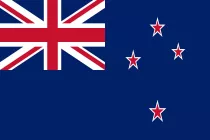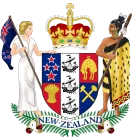New Zealand

Geographical Location of New Zealand
New Zealand consists of the main islands of the North Island and the South Island, as well as several smaller islands. New Zealand is part of a belt of volcanic islands around the Pacific Ocean. The North Island has volcanoes, warm lakes and geysers; this indicates that movements in the earth's crust are still occurring. New Zealand experiences about 14,000 earthquakes every year, some of which are very strong.
New Zealand's climate varies depending on geography and terrain, from cold and wet to dry and subtropical. The westerly wind belt in the southern hemisphere influences the climate as persistent low pressure creates a mild climate.
Due to its long isolation from the rest of the world, New Zealand has a unique flora and fauna. This is now threatened by the spread of alien species on the islands. Today, there are strict laws protecting the remaining forest after large-scale deforestation in the 19th and 20th centuries. The government must also monitor bird species, as some populations are threatened with extinction.
Brief History of New Zealand
New Zealand was settled by Polynesians between 1250 and 1300 and was thus the last major territory to be settled. The Polynesians are known today as Maori. The first European to arrive was probably the Dutchman Abel Tasman at the time of his discovery in 1642.
The Europeans returned only after 120 years. British explorer Captain Cook then mapped the coast. In the early 19th century, British traders, whalers, adventurers and missionaries arrived and settled among the Maori. Conflicts arose between permanent residents and immigrants.
To protect British interests and control development, London sent a representative (magistrate) to New Zealand in 1832. Eight years later, Maori accepted that the country would become a British colony under the Treaty of Waitangi. In return, the British were to provide the Maori with protection and land. Most Maori chiefs submitted to Queen Victoria's rule. Brutal repressions began, and the strife lasted for more than 30 years.
In 1852, New Zealand became a colony with its own government, and in 1907, an independent state in the Commonwealth of Nations. In 1947 the country became completely independent from Great Britain.
Society and Politics of New Zealand
New Zealand is still a member of the Commonwealth of Nations, and the head of state is the British monarch. He is represented by the Governor General. The form of government is parliamentary, so power belongs to parliament. Parliament is elected every three years. The Prime Minister is the true political leader of the country and must have the confidence of Parliament. The government includes about 20 ministers.
There is no written constitution, as the judicial system is based on British traditions. Politics have traditionally been dominated by the National Party and the Social Democratic Labor Party. However, the new electoral system of 1996 somewhat strengthened the small parties.
An important political issue is the issue of Maori demands for compensation. This applies in particular to the land and fishing rights they lost when the British colonized the country.
The United Nations has criticized New Zealand for its low minimum age for committing a crime. Children under the age of 10 can be convicted of murder, and other crimes can be punished from age 14.
Economy and Trade of New Zealand
New Zealand has a small and open economy. Since 1984, the economy has transformed from a closed and regulated economy to a free trade economy. The export of goods such as meat, dairy products, timber, fruits, vegetables and wool is an important source of income. When it comes to wool, sheep and lamb meat, the country is the world's largest producer. The country's electricity needs are met by hydropower and geothermal energy.
The country has many renewable energy sources such as hydroelectric power plants and geothermal power plants. The economy is heavily dependent on trade and is vulnerable to fluctuations in market prices in Asia, Europe and the United States. In 2008, New Zealand became the first industrialized country to enter into a free trade agreement with China. Today, the most important trading partners are China, Australia, Japan and the USA. The country is an attractive tourist destination and the tourism industry is growing. Additionally, New Zealand is famous for its film industry. The wine industry is growing and looks like a promising source of income.
There are some concerns about the New Zealand economy, such as rising household debt at the same time as rising house prices.
New Zealand Cuisine and Culinary Traditions of New Zealand
New Zealand cuisine is not very well known in the world, mainly due to the isolation of New Zealand itself. In addition, New Zealand cuisine has many similarities with Australian cuisine, and both contain similar recipes for dishes. Nevertheless, New Zealand cuisine is quite independent, although little of the traditional dishes of the indigenous people of New Zealand has survived to this day. One of the well-known products, kiwi, was also bred in New Zealand, although its basis is one of the Chinese varieties of such berries. Considering the geographical location of New Zealand, its national cuisine is rich in various recipes for fish and seafood dishes, while a significant share of modern New Zealand dishes is occupied by meat dishes. Basically, New Zealand cuisine is a combination of local products with the culinary traditions of Great Britain, of which New Zealand was a colony for a long time. And some recipes are not even considered New Zealand by many - this is the case with the well-known recipe for Pavlova cake made from bizet and cream, which was created in Portland, New Zealand. Famous dishes of New Zealand cuisine also include meat pie - this dish is very popular both in New Zealand and in neighboring Australia.







